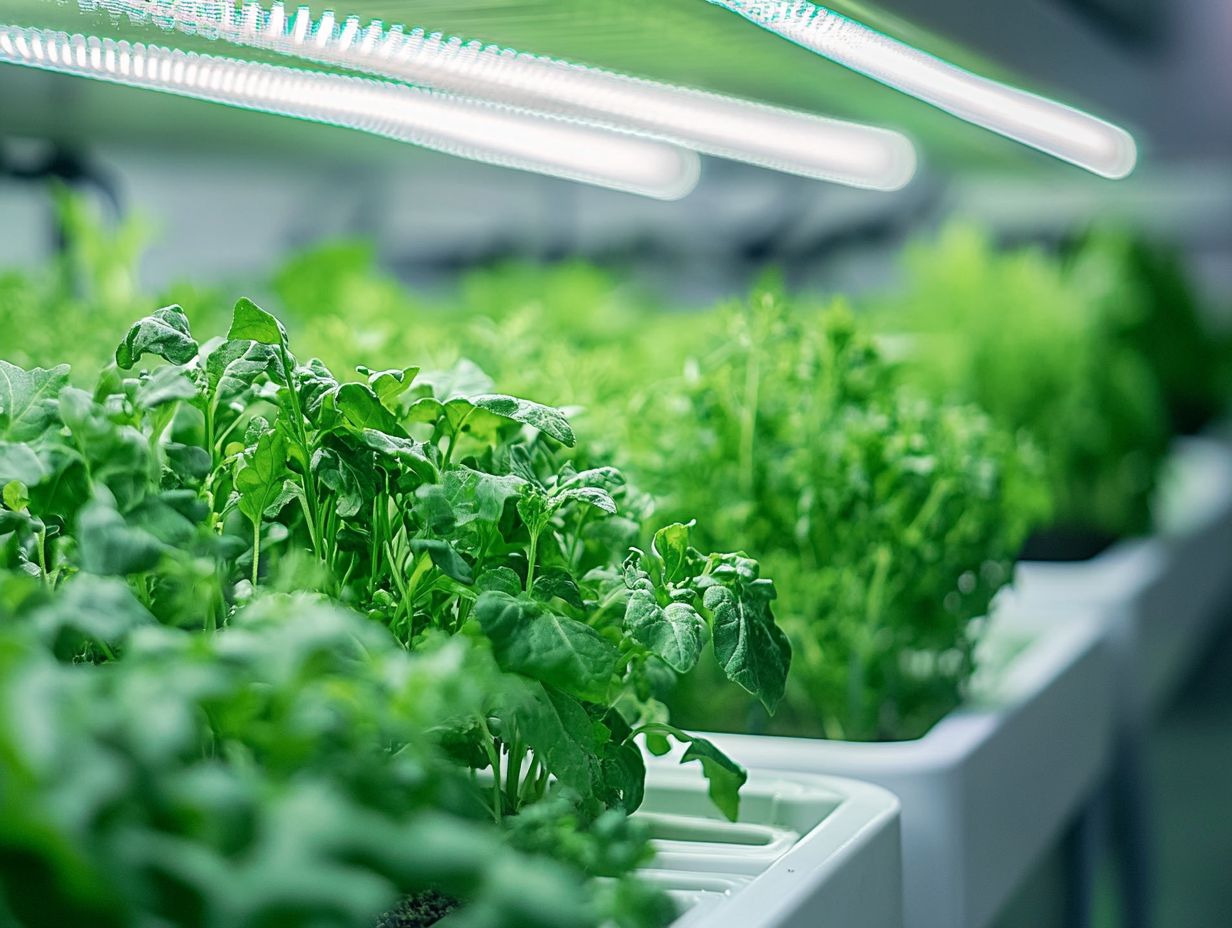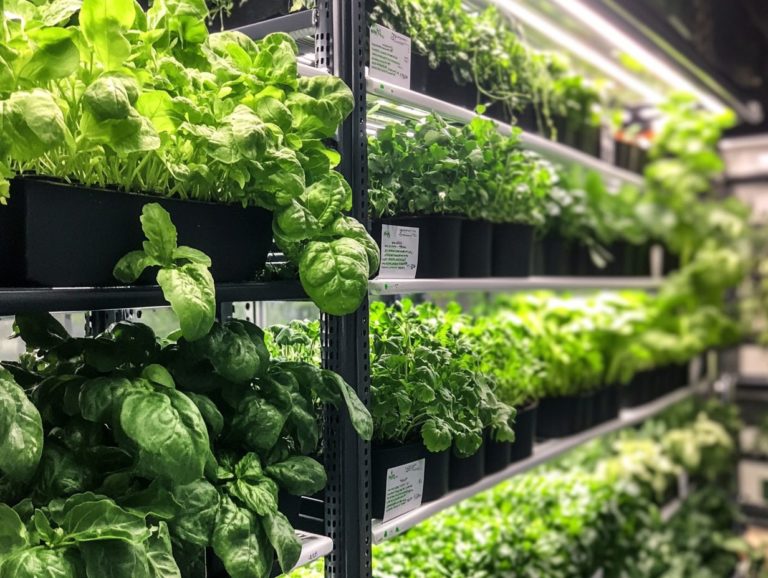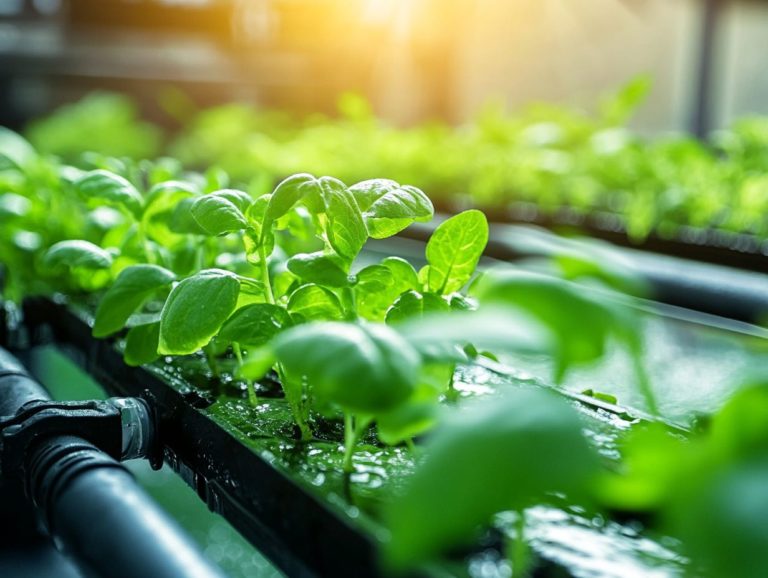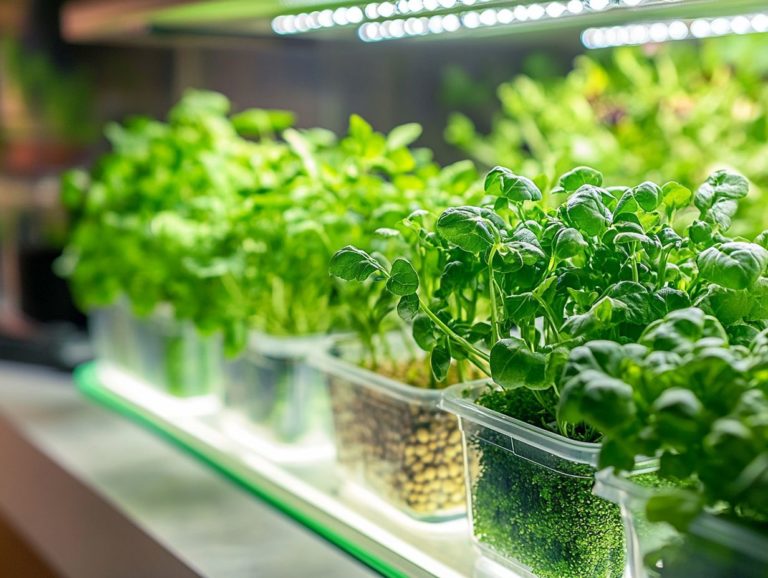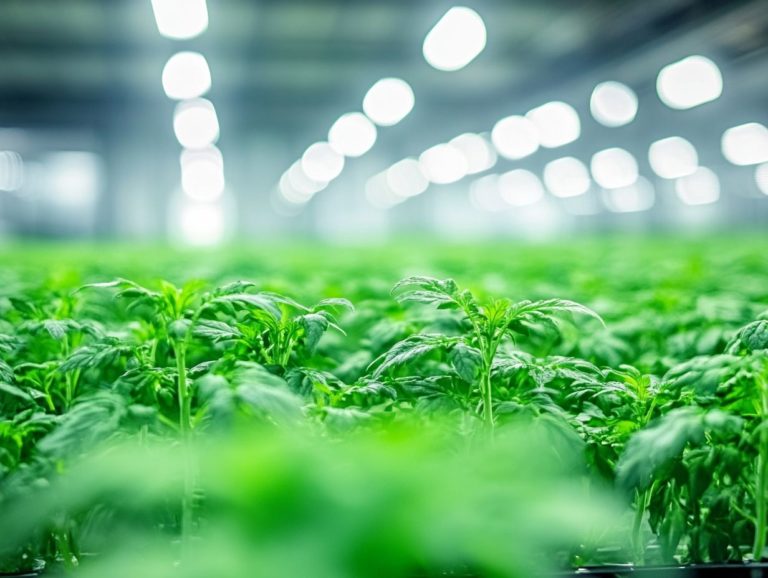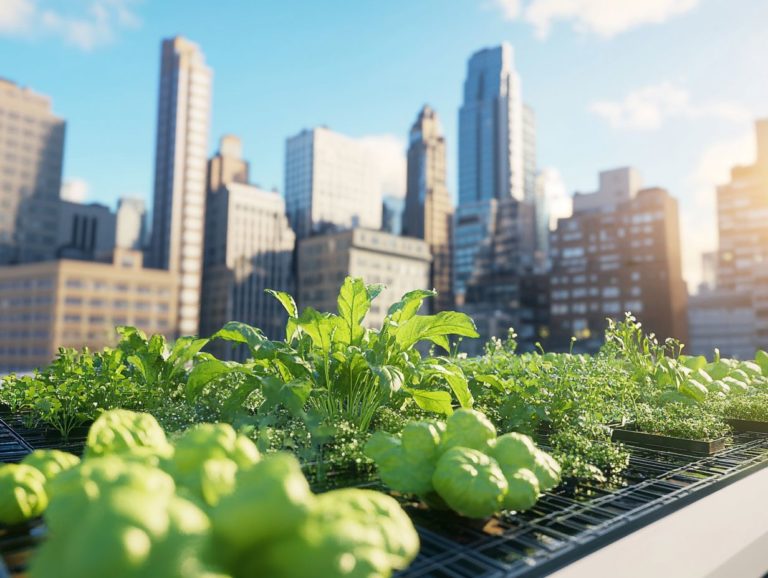5 Essential Features of Hydroponic Systems
Hydroponics is revolutionizing your approach to gardening and food production. This innovative soilless system provides remarkable advantages, from optimizing space utilization to conserving water resources. It showcases efficient use of resources and contributes to a sustainable future.
Whether you re a seasoned gardener or just beginning your journey, understanding hydroponic systems can unlock exciting opportunities for cultivating plants throughout the year.
Get ready to uncover five exciting features of hydroponics, the various systems at your disposal, and the crucial components that ensure everything functions seamlessly.
Explore the possibilities and discover how you can integrate hydroponics into your own garden, addressing modern agricultural challenges.
Contents
- Key Takeaways:
- 1. Efficient Use of Space
- 2. Water Conservation
- 3. No Soil Needed
- 4. Control Over Nutrient Levels
- 5. Year-Round Growing
- What Is Hydroponics and How Does It Work?
- Frequently Asked Questions
- What are the 5 essential features of hydroponic systems?
- Why is a nutrient solution important in hydroponic systems?
- What types of growing mediums can be used in hydroponic systems?
- How does the water supply work in hydroponic systems?
- Why is oxygenation important in hydroponic systems?
- What role does lighting play in hydroponic systems?
Key Takeaways:
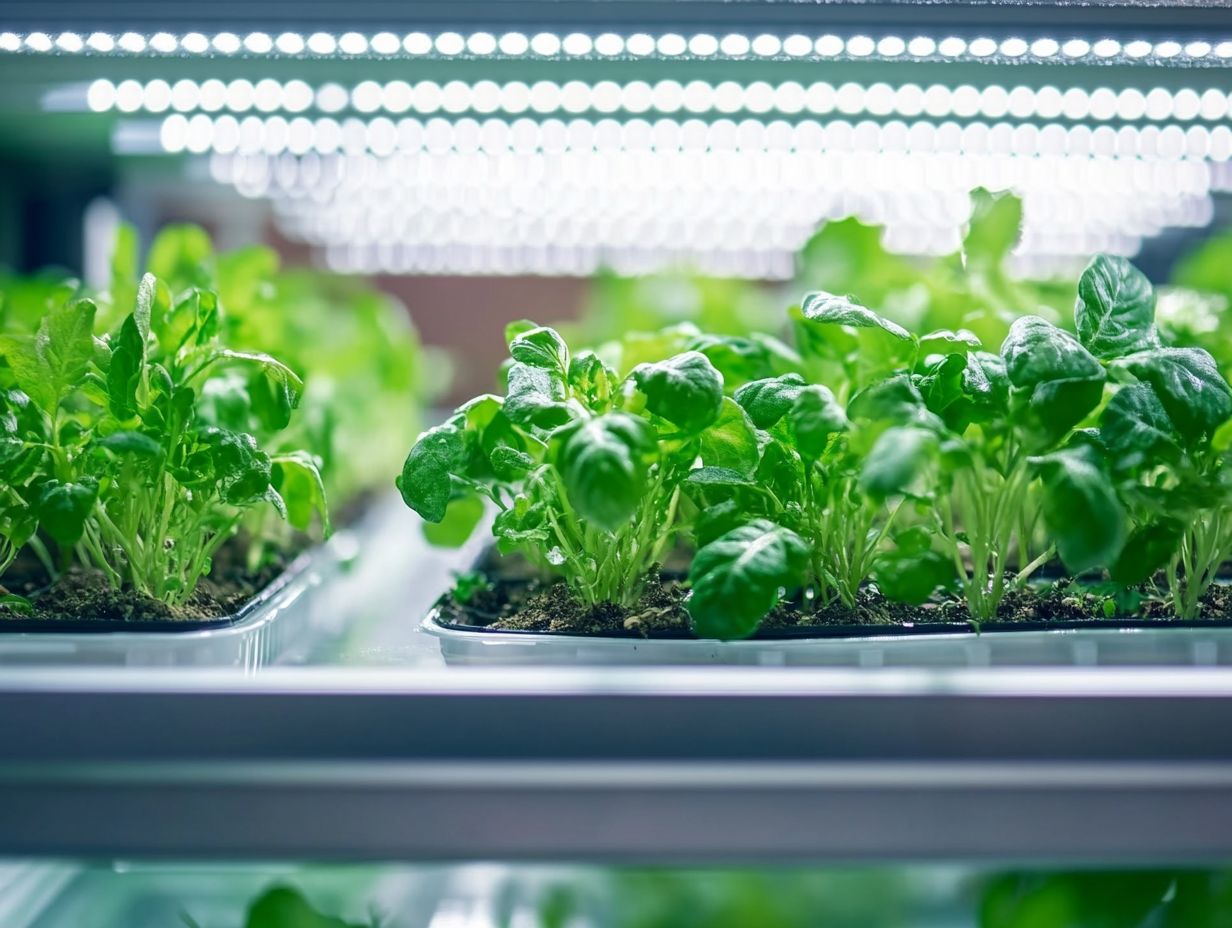
- Unlock more garden space with hydroponics!
- Reduce your water use by up to 90%!
- Grow plants without soil, perfect for urban or indoor gardening.
1. Efficient Use of Space
In your quest for a sustainable future, consider how hydroponics can efficiently use space in urban environments. This groundbreaking approach to plant cultivation offers remarkable advancements in food production and crop yield while reducing challenges faced by traditional agriculture.
By utilizing soilless systems, you can optimize vertical farming, which means growing plants in stacked layers and taking full advantage of controlled conditions. This method maximizes growth in limited spaces, alleviating pressure on conventional agricultural land and resources.
Imagine transforming rooftops, warehouses, and even abandoned lots into productive farms. By employing advanced techniques like nutrient film technique, deep water culture, and aeroponics, cities like New York and Chicago have showcased successful initiatives such as Brooklyn Grange and Urban Roots. These projects have turned urban landscapes into vibrant green spaces that provide fresh produce to local communities.
These innovative systems not only cut down on food miles, leading to a lower carbon footprint, but also enhance biodiversity and resilience within food supply chains. Embracing hydroponics and vertical farming could be your key to enhancing food security and fostering eco-friendly practices in densely populated urban areas.
2. Water Conservation
Water conservation is vital in modern agriculture. Hydroponics presents a sophisticated solution that significantly reduces water usage compared to traditional farming methods.
These systems maximize water efficiency by using a method that minimizes waste. By integrating reverse osmosis processes, you can keep the water pure and free from contaminants, promoting plant health. This purification mechanism protects your crops and supports sustainable practices by decreasing the need for chemical fertilizers and pesticides.
By reducing runoff and eliminating excess water usage, hydroponic systems provide a compelling strategy for agricultural resilience and water conservation. They play an essential role in eco-friendly farming efforts, effectively addressing challenges brought on by climate change.
3. No Soil Needed
The advent of hydroponics, a cultivation method without soil, has transformed the landscape of plant growth. This innovative approach enables various crops to flourish without traditional soil, making it particularly advantageous for urban settings and areas plagued by poor soil quality.
By embracing this system, you significantly diminish the risk of pests and diseases. The controlled environment effectively limits exposure to harmful organisms. You can experiment with alternative growth media, such as coconut coir or perlite, which often foster healthier root systems.
Hydroponics promotes environmental sustainability. This method utilizes up to 90% less water than conventional farming and minimizes land usage, making it an enticing choice for densely populated regions.
Successful hydroponic crops like Romaine lettuce, tomatoes, and mustard greens not only grow at an accelerated pace but also generally boast enhanced flavors and nutrients. This provides consumers with a fresher option while bolstering local food systems and improving food production.
4. Control Over Nutrient Levels
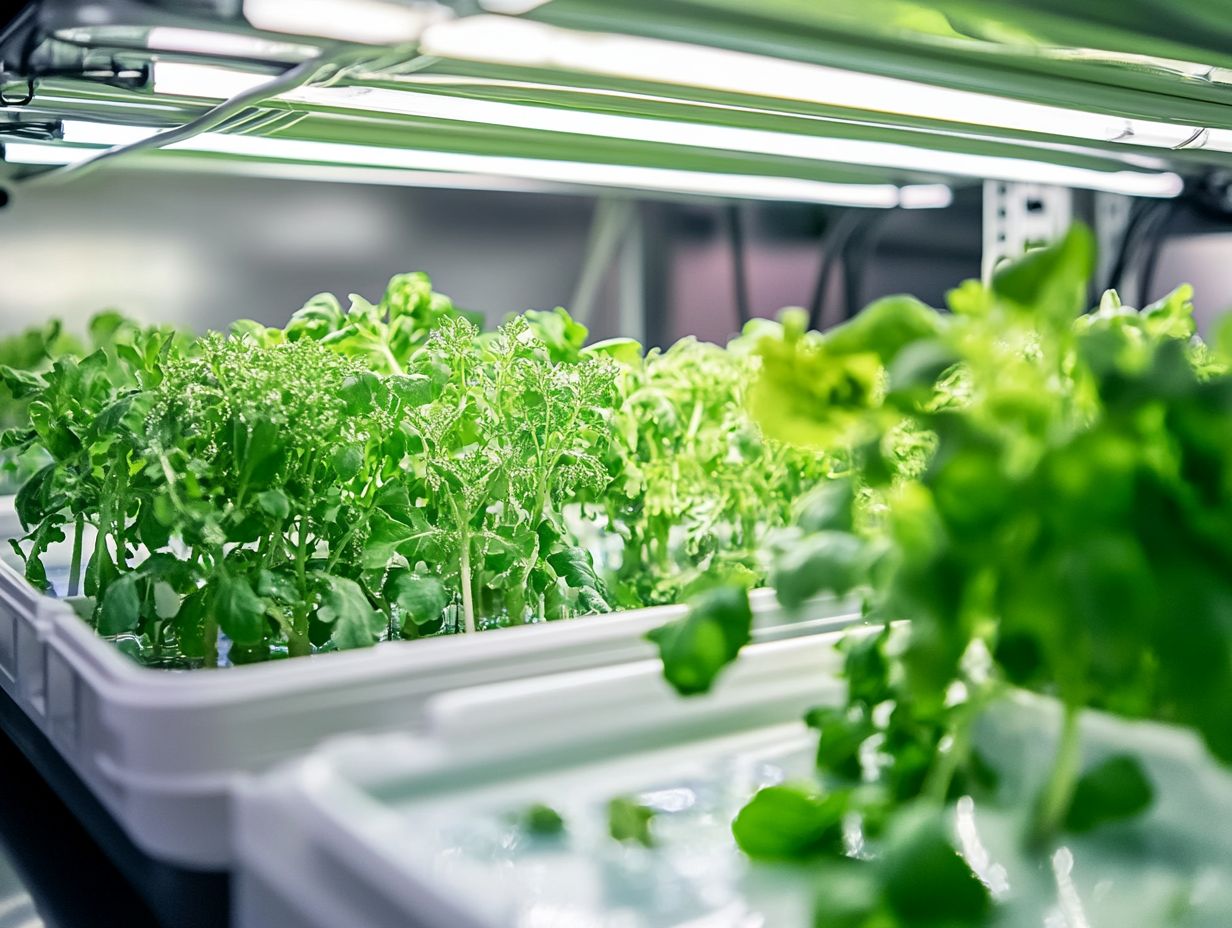
One of the standout advantages of hydroponic systems is the exceptional control you have over nutrient levels. This control facilitates nutrient balance and ensures optimal plant health. You can customize nutrient solutions specifically designed for optimal plant health and crop quality, ultimately leading to impressive yields.
This meticulous management of nutrients is vital. It directly affects the growth rate, flavor, and nutritional value of your crops. You can fine-tune the concentration of the main nutrients that plants need to grow, like nitrogen, phosphorus, and potassium, to meet the specific needs of each plant.
For example, if you re growing leafy greens like lettuce, you would benefit from higher nitrogen levels to promote that vibrant foliage. Conversely, fruit-bearing plants like tomatoes thrive when given more potassium, which enhances fruit development.
By harnessing these tailored custom nutrient plans, you can unlock the full potential of your crops. This results in top-notch quality and a competitive edge in the market!
5. Year-Round Growing
Hydroponics allows you to cultivate crops year-round by creating a controlled environment that protects your plants from seasonal variations, pests, and diseases. Imagine enjoying fresh produce every season!
This cutting-edge approach not only boosts crop yield and quality but also plays a vital role in enhancing food security in an increasingly unpredictable climate. With hydroponic systems, you can efficiently grow a variety of crops like Romaine lettuce, tomatoes, and herbs regardless of external conditions, even in micro-climates.
Urban farms are showcasing the wonders of hydroponics, especially in places like Singapore. There, limited land prompts the use of vertical farming techniques that optimize space and minimize resource consumption. These systems, often outfitted with smart technology to monitor nutrient levels and light exposure, create an ideal environment for crops to flourish consistently. This marks a significant advancement in agricultural sustainability.
Ready to start your hydroponic journey? Dive into this exciting world today!
What Is Hydroponics and How Does It Work?
Hydroponics is an innovative agricultural method. It allows you to cultivate plants in a nutrient solution instead of soil, enhancing food science and contributing to sustainable initiatives.
By utilizing a controlled environment, you can optimize growth and productivity, placing hydroponics at the forefront of contemporary food science and sustainable agriculture. To get started, consider the 5 essential tools for hydroponic gardening that can enhance your setup.
This method depends on several components, such as water reservoirs, nutrient delivery systems, and growing trays. These components ensure your plants receive the precise nutrients and moisture needed for healthy growth, with a focus on water purity through reverse osmosis, a process that purifies water by removing impurities. Additionally, exploring innovative hydroponic growing technologies can further enhance your gardening experience.
By employing techniques like nutrient film technique (NFT) and deep water culture (DWC), hydroponics enables you to grow crops year-round, free from the seasonal challenges that often accompany traditional soil-based farming. Discovering 5 reasons to try NFT hydroponic systems allows for seasonal harvesting and efficient use of resources.
This approach is a game-changer for sustainable farming! It conserves water, reduces land use, and minimizes reliance on pesticides, all while boosting crop yields. As global food demand continues to rise, hydroponic systems offer an efficient and sustainable solution to meet the nutritional needs of the growing population.
What Are the Different Types of Hydroponic Systems?
There are various types of hydroponic systems, each employing distinct techniques such as nutrient film technique, deep water culture, and ebb and flow. Each system is tailored to meet the specific needs of different plants and optimize their growth.
By familiarizing yourself with these hydroponic methods, you can select the most appropriate option for your crops. For example, the nutrient film technique circulates a thin film of nutrient-rich water over the roots, making it ideal for growing leafy greens such as lettuce and herbs due to its efficient oxygenation. To delve deeper into this topic, consider exploring understanding the basics of hydroponic systems.
In contrast, deep water culture immerses the roots in a nutrient solution, which is perfect for larger plants like tomatoes or peppers, as it facilitates excellent nutrient uptake.
Ebb and flow, on the other hand, periodically floods and drains the grow bed, accommodating a diverse array of crops. When you compare the resource use of each system, you’ll notice varying efficiencies in water usage and nutrient delivery. For a deeper understanding of different methods, check out hydroponic systems: what you need to know. This underscores the importance of thoughtful selection based on both plant type and environmental factors.
What Are the Key Components of a Hydroponic System?
Figure 1: Key components of a hydroponic system.
A successful hydroponic system is built on several key components: air stones for oxygenation, growing trays for plant support, and meticulously calibrated nutrient compositions. To enhance your setup, consider following these 7 tips for successful hydroponic gardening. These elements promote rapid growth under controlled lighting conditions, which are crucial for achieving high-quality crops.
Each element is essential for creating a thriving environment for your plants. Air stones efficiently distribute oxygen throughout the nutrient solution, ensuring that roots receive the essential gas necessary for respiration. Growing trays provide sturdy support, allowing roots to interact seamlessly with the nutrient-rich water below. To maximize your output, consider exploring 5 hydroponic systems for maximum yield.
It s important to balance nutrient mixtures carefully, as they need to deliver essential minerals and elements tailored to the specific needs of your plants.
When it comes to lighting, you ll often choose between LED or fluorescent options. Adjust the intensity and duration to mimic natural sunlight for optimal photosynthesis. Regular maintenance is non-negotiable; you ll need to monitor pH levels, which measure the acidity or alkalinity of the nutrient solution, clean components, and replace water to maintain that delicate balance and encourage robust plant growth.
Proper setup demands thoughtful planning to ensure all components work in harmony together.
How Can One Set Up a Hydroponic System?
Setting up a hydroponic system involves important steps.
You need to choose the right system, ensure your water is clean, and prepare a liquid food mix to help plants grow.
To begin this journey, it’s vital to understand the different hydroponic systems available, such as deep water culture, nutrient film technique, and aeroponics. For beginners, exploring the top 5 hydroponic growing systems can help you choose the right one. Each system has its unique advantages tailored to various crops and growing environments.
Once you ve selected your system, assessing water quality becomes essential. Techniques like reverse osmosis or UV purification can effectively rid your water of harmful pathogens and impurities, providing a solid foundation for your plants.
Next, preparing a balanced nutrient solution is crucial. You want to ensure that essential big and small nutrients are present in the right proportions to support robust growth.
Carefully consider how to design your system, including lighting and airflow, to meet your specific crop requirements. For those new to this method, following a beginner’s guide to hydroponic systems can provide valuable insights. This attention to detail can significantly enhance your yield and overall success in hydroponic gardening.
What Are the Benefits of Using a Hydroponic System?
Utilizing a hydroponic system presents you with great benefits, including efficient resource use, higher crop yields, and a positive impact on environmental sustainability compared to traditional farming methods.
Hydroponics uses less land and cuts water use by up to 90%. It delivers nutrients directly to plant roots for better growth, ensuring optimal conditions. Research indicates that hydroponically grown crops can yield 30-50% more produce per square foot than their soil-based counterparts.
For example, a USDA study found that certain hydroponic setups can produce leafy greens with nutrient profiles that outperform those grown in soil, all while requiring less fertilizer.
This innovative approach not only bolsters food security but also significantly reduces the environmental footprint of agriculture.
What Are the Common Challenges in Hydroponic Gardening?
Hydroponic gardening has specific challenges to manage. You will need to control pests, maintain nutrient balance, and handle system upkeep.
These challenges can lead to frustration, whether you are just starting out or have been cultivating plants for years. For example, pests can multiply rapidly in the nutrient-rich environment. Any imbalance in nutrients may stunt plant growth or cause deficiencies.
To tackle these issues effectively, it s essential to regularly monitor key environmental factors, such as pH levels, light intensity, and temperature.
Implementing preventative measures like introducing beneficial insects and sterilizing your equipment can significantly reduce the risk of potential outbreaks. By staying vigilant and making adjustments as necessary, you can create a thriving hydroponic ecosystem that supports healthy plant growth and maximizes your yields.
Frequently Asked Questions
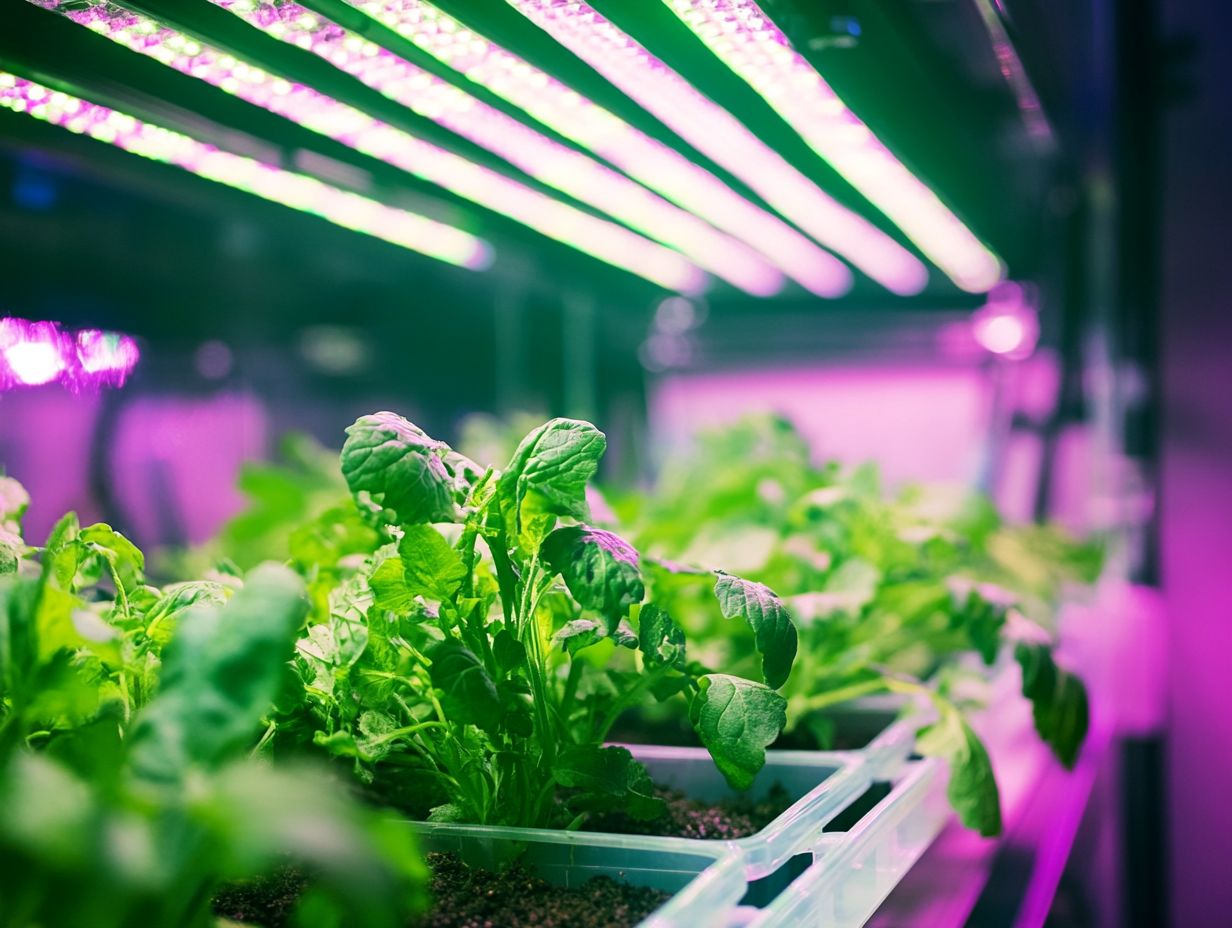
What are the 5 essential features of hydroponic systems?
Great question! The 5 essential features of hydroponic systems are a nutrient solution, growing medium, water supply, oxygenation system, and lighting.
Why is a nutrient solution important in hydroponic systems?
A nutrient solution is important in hydroponic systems because it provides the necessary nutrients for plants to grow and thrive without soil.
What types of growing mediums can be used in hydroponic systems?
Some common growing mediums used in hydroponic systems include rockwool, expanded clay pellets, coco coir, and perlite.
How does the water supply work in hydroponic systems?
The water supply in hydroponic systems is typically a recirculating system that delivers the nutrient solution to the roots of the plants through tubes or channels.
Why is oxygenation important in hydroponic systems?
Oxygenation is vital in hydroponics. It ensures plant roots get enough oxygen to thrive and prevents harmful bacteria from growing.
What role does lighting play in hydroponic systems?
Good lighting isn t just important; it’s a game-changer! It fuels your plants’ growth and vitality.

